Amazon PPC Course 3: Setup, Match Types, Keywords & Bidding

Many Amazon sellers – like you – take a swing at creating a new PPC campaign, hoping for the massive returns that are promised all over the internet. You test a ton of keywords on sponsored ad campaigns, bid high, and change match types – over and over again without reaching the light at the end of the tunnel. It feels like all you’re doing is throwing money away.
That is why we have created a 3-part series to help sellers with Amazon-sponsored ads.
We recommend reading part 1 and part 2 of the series before you get started with part 3.
In part 1, we cover the basics of Amazon sponsored ads – how to set it up and how to ensure your advertising goals align with your business needs.
Part 2 will bring you up to speed with all the buzzwords thrown around when it comes to Amazon PPC. We dive into key PPC metrics like advertising cost of sale (ACoS) and explain how you can calculate your ideal Amazon advertising budget.
In part 3, we dive into the different PPC targeting options and Amazon keyword match types. We also look at how you can structure your campaigns to maximize profitability and sales.
- Sponsored ads: Automatic v/s manual campaigns
- Automatic targeting
- Manual targeting
- Introduction to campaign structures: best practices
- Grouping your products
- Naming conventions
- Initial Bid Price
- From the experts: The SellerApp campaign strategy
- Run automatic and manual campaigns
- Use negative targeting
- Optimize regularly
- Final thoughts
Sponsored ads: Automatic v/s manual campaigns
There are two ways to run a sponsored product ad campaign. You can set it to automatic or manual targeting. Sponsored display ads and sponsored brand ads have to be manually managed.
Automatic targeting
In an automatic campaign, Amazon’s algorithm finds relevant keywords and identifies relevant or complementary products to be targeted based on your product listing. Over time, Amazon uses the data it collects from clicks and purchases to optimize the ads for conversions. It cannot be manually optimized.
Since Amazon discovers relevant keywords from your listing, your product listing copy must be search engine optimized. Include the top keywords in the title, bullet points, and product description. Make sure that you populate the amazon backend keywords with relevant search terms as well.
Sellers can choose from four different match types when creating an auto campaign.
- Close match: Search terms closely related to the products.
- Loose match: Search terms loosely related to the products.
- Substitutes: Show ads to customers who visit product pages of similar products.
- Compliments: Show ads to customers who visit product pages of items that complement yours.
Based on the ACoS or the ROI for each target type, you could decide to turn off a few. Alternatively, you can increase or decrease the bid for the ad group.
Auto campaigns are often not the best campaigns for conversions and ACoS, yet they help discover new, high-converting amazon long-tail keywords.
Expert Tip to identify new keyword opportunities:
Mark the keywords/ASINs targeted in manual campaigns as ‘negative’ in automatic campaigns. This ensures that your auto campaigns show ads for new search terms and ASINs. You could add these new keywords/ASINs to your listing and target them manually based on the conversion rate.
Manual targeting
In a manually targeted campaign, the seller inputs the keywords/products to run the ad for, along with the bid for each keyword/product. The entire process is manual, so you need to monitor what keywords and products you are targeting as well as change bids regularly to optimize your campaigns. Since optimization is manual, you have more control over ad spending. Manual targeting is the go-to solution to reduce your advertising cost of sale (ACoS) and to enable long-term profitability.
Depending on your advertising campaign goals, you have three Amazon keyword match types to choose from.
- Broad match: Your ad will be triggered when a shopper searches for your keywords in any order, along with other close variants. While broad match keywords do not guarantee the best returns, they are a great way to gather data. Start with a broad match to find new keywords and improve ad visibility.
- Phrase match: Your ad will be displayed if a buyer searches for the keywords in the same order along with either suffixes or prefixes.
- Exact match: The ad will only be displayed when a buyer searches for the exact keywords. The search term cannot include any other words or phrases. This is the most refined targeting option. High-converting keywords with exact match generally yield better ROI and have lower ACoS. This comes at the cost of visibility that you would have received if you were using broad match or phrase match targeting.
Note: Amazon searches are not case-sensitive.
This table clearly illustrates the three different Amazon keyword match types with examples.
| Match Type | Keyword | Ad will be displayed for | Ad will not be displayed for | Can include |
|---|---|---|---|---|
| Broad | running shoes | running shoes, men’s running shoes, waterproof men’s shoes running, running shoes women’s | Loafers, sandals, men’s sandals | Synonyms, acronyms, misspellings, variations, singulars and plurals |
| Phrase | running shoes | waterproof running shoes, grey running shoes, men’s running shoes, running shoes for women | running waterproof shoes, trekking shoes, running men’s shoes | Misspellings, singulars and plurals, acronyms, and abbreviations |
| Exact | running shoes | running shoes, running shoe, running shoes | waterproof running shoes, men’s running shoes, women’s running shoes | Singulars, plurals, and misspellings |
Product targeting allows you to choose specific products, categories, brands, or other product features that are relevant to the product in your ad.
When running a product targeted Amazon sponsored ad campaign, sellers have two targeting options.
- Product ASIN targeted: You can directly target and bid on specific products/ASINs. Targeting can be refined based on brand, price, or product rating.
- Category targeted: This allows you to display your ad in search results and product ASIN page coming under the targeted category. You can also refine category-based targeting by brand, price, and product rating. Sponsored product ads and sponsored display ads can also be targeted by Prime shipping eligibility.
Note: With product targeting, you can target categories and products individually or target a combination of categories and brands in the same campaign.
The modus operandi for both Amazon keyword targeting and product targeting is similar.
Expert Tip:
Broad targeting methods like Amazon broad match and category-based targeting will help you discover new keywords and positive ASINs. The top performers can be targeted directly with exact match or ASIN targeting. This will allow you to maximize your returns from them with granular bid optimization.
Introduction to campaign structures: best practices
Now that you know your targeting and match-type options, let’s take a look at how to structure your PPC campaigns. A messy campaign structure can directly affect your bottom line. It is almost impossible to scale or optimize unstructured campaigns. Well-structured ones will let you easily monitor your campaigns and enable you to budget more efficiently.
Let’s start with the basics.
Grouping your products
The best practice for grouping is sorting by
- Similar products
- Similar keywords
- Same match type for keywords
Let’s assume you have a product line of running shoes.
You have shoes for both men and women, in different colors, sizes, and patterns. These shoes could be categorized into groups based on various factors.
One grouping could be based on whether it’s men’s shoes or women’s shoes. Another group could be shoes of the same color. Another one could be based on the price. While there are several ways to group your products, campaigns are easier to manage when you group them based on keyword similarity.
What you need to do is identify similar products from your catalog and add them to the same ad group. Keep products with similar keywords in the same ad group. You could have ad groups based on color, based on match type, or based on goals.
Grouping campaigns based on match-types can help you avoid duplication and enable better optimization. For instance, exact and phrase match type targeting are more refined and can be better optimized for higher RoAS.and lower ACoS. Grouping your campaigns based on match types will let you easily track how specific keywords are being targeted and help you avoid costly duplications.
Grouping based on the campaign goals is another great way to stay on top of your ad groups. For instance, you can create ad groups to target holiday-specific keywords or ASINs. If you’re selling strip lights on Halloween, you can create a separate ad group to target keywords like ‘Halloween strip lights’ or ‘deals on strip lights for Halloween’.
Naming conventions
Have a naming convention planned for your campaigns before you get started. If you’re planning to make it big on Amazon, you need to create multiple sponsored ad campaigns. It’s one of the most efficient ways for you to scale your business – if you’re doing it right.
Your naming convention should enable you to easily keep track of all the campaigns you create.
The naming convention we use at SellerApp is something that could work. You can use it when you start with just a few campaigns or even when you scale up to 30-40 campaigns.
[Product Identifier] + [Campaign Type] + [Targeting] + [Additional Info]
You can check the flowchart to get a better idea of how we name and structure our campaigns.
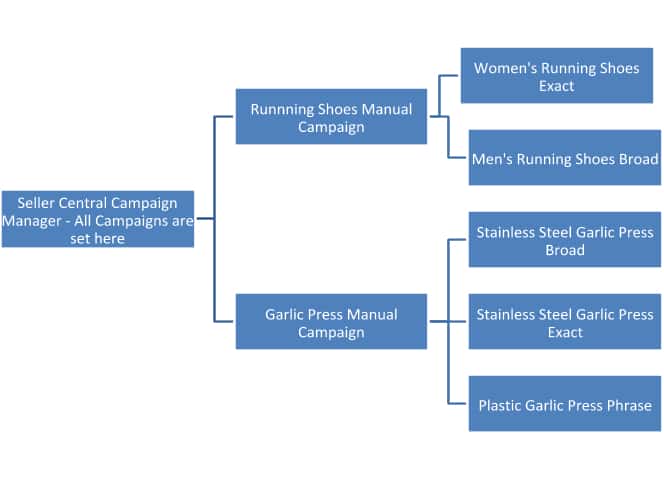
DO NOT make your naming convention and your campaign structure complex. You should be able to easily track your ad groups and campaigns.
Bidding strategies for beginners
Once you’ve set up a campaign, you also need to place your bids. Every keyword or ASIN has different levels of competition for ad space, so there is no one size fits all strategy. Luckily, Amazon suggests bid ranges. Amazon suggested bids are usually a safe bet and will ensure you get impressions.
From the experts: The SellerApp campaign strategy
The best Amazon PPC strategy will depend on your business goals. There isn’t a single strategy that all the top sellers employ. However, there are a few things that every seller needs to do to get optimal results. Our PPC experts consistently use these strategies along with SellerApp’s amazon data analytics tools to deliver the best results for our clients. Thousands of sellers have managed to boost their revenue by more than 30% by using these strategies in tandem with the SellerApp platform.
A combination of automatic and manual campaigns gets your products better reach
Automatic campaigns help find new keywords. Though this is usually at the cost of having a high ACoS, uncovering these new terms makes it worth running them. Automatic campaigns usually tend to get better reach (read impressions) than manual when you are just starting.
Manual campaigns, on the other hand, can be optimized for better performance by bid optimization and adjusting the keyword match type. Run manual campaigns for,
- The top product keywords
- Converting search terms from automatic campaigns
The key here is to review your automatic campaigns regularly and harvest the converting keywords. Shift these high-value keywords to your manual campaigns for further optimization. Automatic campaigns and manual campaigns must be used in tandem for the highest returns.
Keyword harvesting is easy on SellerApp. Log in to the SellerApp dashboard and navigate to the ‘Advertising’ section.
- On the advertising dashboard, select the Insights option.
- Click on Auto to Manual to get a list of all the top converting keywords and targeted ASINs. SellerApp automatically harvests these keywords and target ASINs from your automatic campaigns based on their performance.
- Select Move to Manual to shift these keywords/targeted products to your manual campaign for bid optimization and better targeting.
Note: When you shift a keyword from an automatic campaign to a manual campaign, mark them as ‘negative’ in the former. This is to avoid keyword duplication between campaigns and ensure you don’t compete against yourself for the same keyword.
Use negative targeting
Have you noticed keywords or targeted ASINs with a high click-through rate (CTR) but no sales?
There are two reasons why this happens.
- The keyword is not closely relevant to your product
- The keyword is relevant but has low conversion rates.
If you discover such keywords or ASINs, we recommend that you mark them as negative. Once you mark a keyword as ‘negative,’ your product ads will not show up for those keyword searches. This will help you reduce your ACoS by minimizing wasted ad spend on non-performing keywords and non-optimal targeting.
There is a limit of four words per negative keyword and up to 80 characters Amazon Negative keywords can further be categorized into two types:
- Negative phrase: Ads don’t show search terms that contain the complete phrase or close variations.
- Negative exact: Ads do not show for queries that contain the exact phrase or close variations.
Suppose you want to mark the keyword ‘gaming mouse’ as negative. If you use negative exact your ad will no longer be displayed for the search term – gaming mouse. It may still show up if people search for ‘gaming mouse for laptops’, ‘600dpi gaming mouse’, or even ‘mouse gaming’.
If you use negative phrase targeting, your ad will not show for the exact search term, and close variations, including suffixes and prefixes. In the case of ‘gaming mouse’ – ‘gaming mouse for laptops’ will be marked as negative ‘600dpi gaming mouse’
Similar to negative keywords, you can also mark products or brands as negative if you are using product targeting. The underlying principles remain the same. When you mark a brand or ASIN as negative, your ad will not be displayed for search queries for them. Your ad will not show up on the product pages of those brands or of that exact ASIN.
With SellerApp, you don’t have to crawl through all your campaigns and data to identify potential non-performers. Our machine-learning algorithm identifies negative keywords and ASINs and will prompt you to mark them as negative.
The first thing you need to do is log in to SellerApp, and open the advertising console. Then, just follow these steps:
- Under Insights, select Negative Keywords to get a list of underperforming or irrelevant keywords.
- Select Negative ASINs to get a list of underperforming or irrelevant ASINs.
- Click Mark Negative to ensure the respective keyword or ASIN is not targeted.
Optimize regularly
The best way to get the most out of your campaigns is to optimize them regularly. This is a full-time job. Regularly harvest keywords, mark non-performers as negative, identify high-converting keywords, and adjust your bids. However, an Amazon PPC tool can automate this strategy, accurately without manual intervention.
If your campaigns get good traffic – high impressions and clicks but have low sales, your listing needs optimization. Update your listings with excellent photos and optimize the factors that increase the conversion value – pricing, reviews.
No seller is going to create a perfect ad campaign on day 1. This is an iterative process that will need constant attention and monitoring.
We suggest a simple odd-even rule to manually optimize campaigns.
To ensure that you cover all the important aspects of Amazon PPC campaign optimization, divide the month into odd and even weeks:
Even Week: On even weeks, optimize individual ad campaigns based on the campaign goals.
Start by analyzing the ACoS, sales, impressions, and clicks of your keywords and targeted ASINs. This will help you get an idea of what is working and what isn’t. For keywords, you can also consider shifting the high-performing ones to the exact match type to focus on bid optimization
The next part – bid optimization. You need to do this for each keyword or ASIN in every campaign. We usually bid higher for campaigns with exact match keyword targeting or optimized product targeting. This is based on the assumption that only high-converting keywords are being targeted with an exact match. Since these keywords and ASINs have a proven track record of bringing in sales, it is worth the extra investment to capture more ad space.
Likewise, avoid high bids for broad match keywords or category-based targeting because this kind of targeting is all about casting a wide net and gathering data. Broad match and category-based targeting don’t offer the most optimized returns, so our bids here usually align with the suggested bid or are slightly lower.
Odd Week: On odd weeks, look for new keywords or ASINs to target. Also, shift all the harvested keywords and positive ASINs to manual campaigns. Gathering actionable data about keywords and ASINs can take a few weeks. That’s why it is important to wait and track them for a week or more before taking a call on what to do with them.
If you’re following all these tips, this is what the flowchart of a sponsored product campaign will look like:
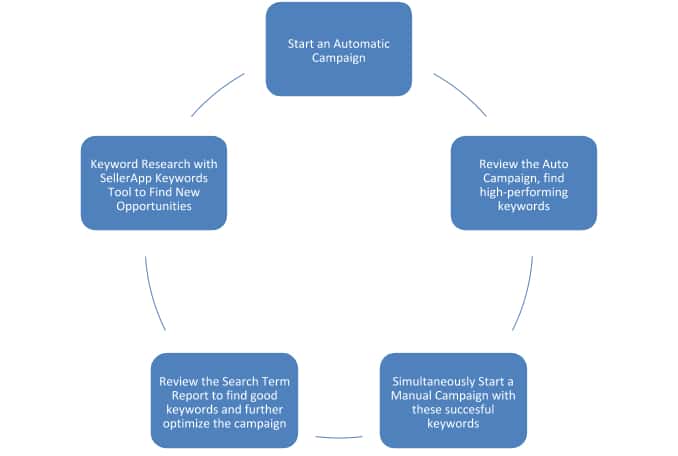
Final thoughts
Amazon sponsored ads are one of the best ways to boost your sales on the e-commerce platform. Advertising on Amazon is booming with the retail giant pocketing 13% of total revenue from search ads in the US in 2019. More and more sellers are tapping into the potential offered by Amazon PPC campaigns.
However, Amazon PPC is complex and there is a chance that you can lose money due to inefficiency. It’s not easy to get comprehensive data to inform your choices either. That’s why SellerApp is designed to seamlessly sync with your Amazon account. SellerApp gives you all the data and tools you need to effortlessly manage your advertising campaigns – all in one dashboard.
Still unsure about how to manage your Amazon advertising? Well, we also have a team to take care of it. Our personalized PPC management solutions bridge machine learning and human expertise to guarantee the best returns.
Additional Resources
- For an Amazon PPC Step By Step Guide
- Amazon PPC bulk operations.
- Amazon Retail Analytics Mystery Revealed
- Amazon PPC Setup & Things to Remember Before You Start
- Amazon Sales Rank Explained



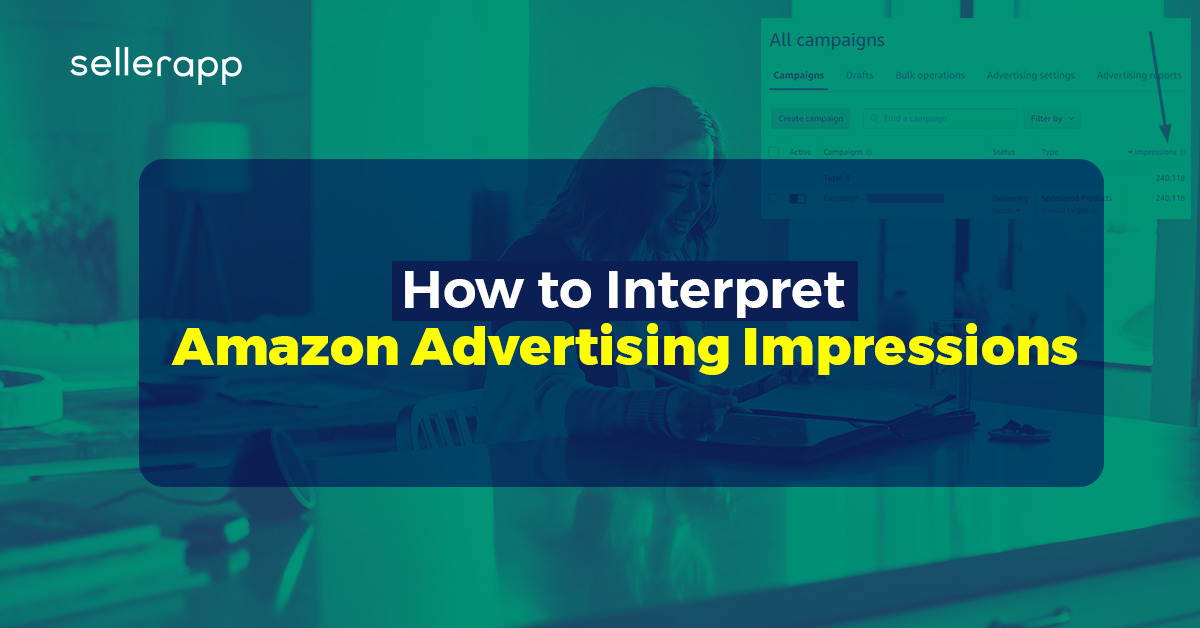



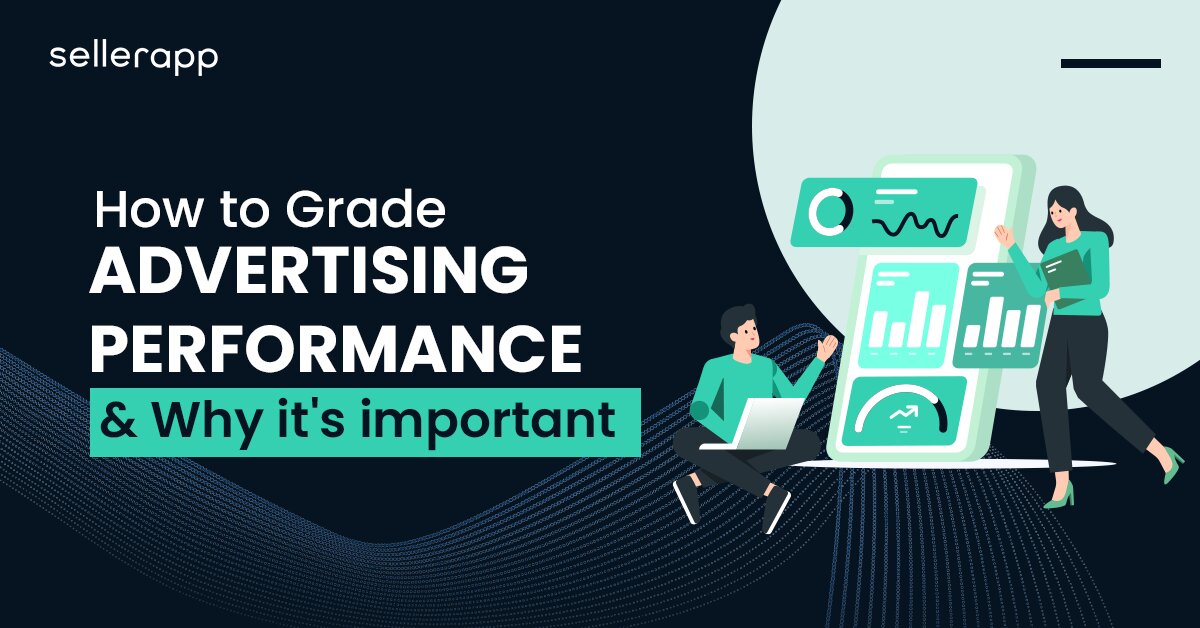
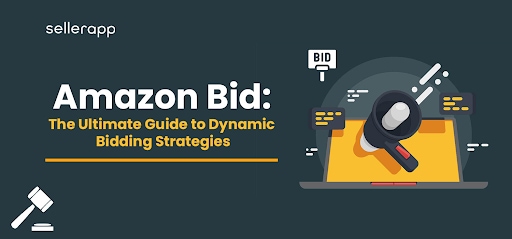
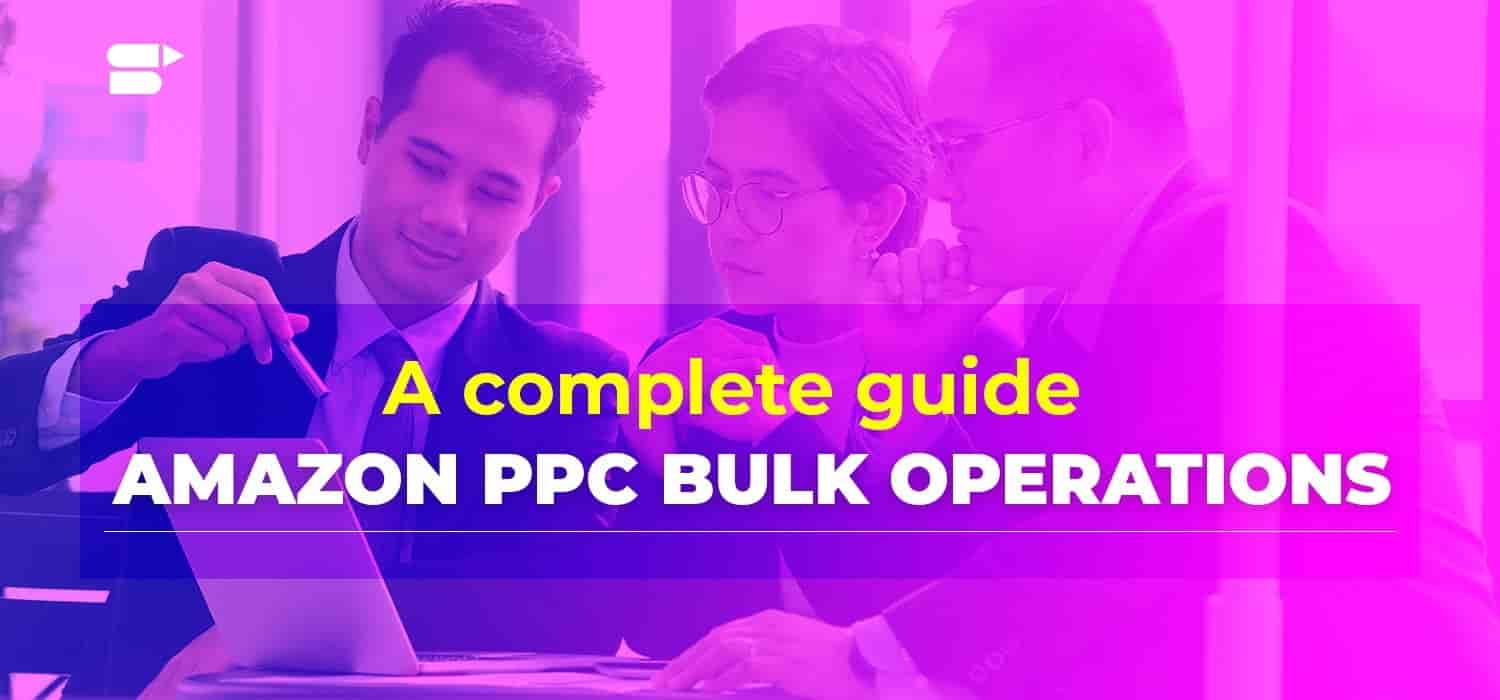
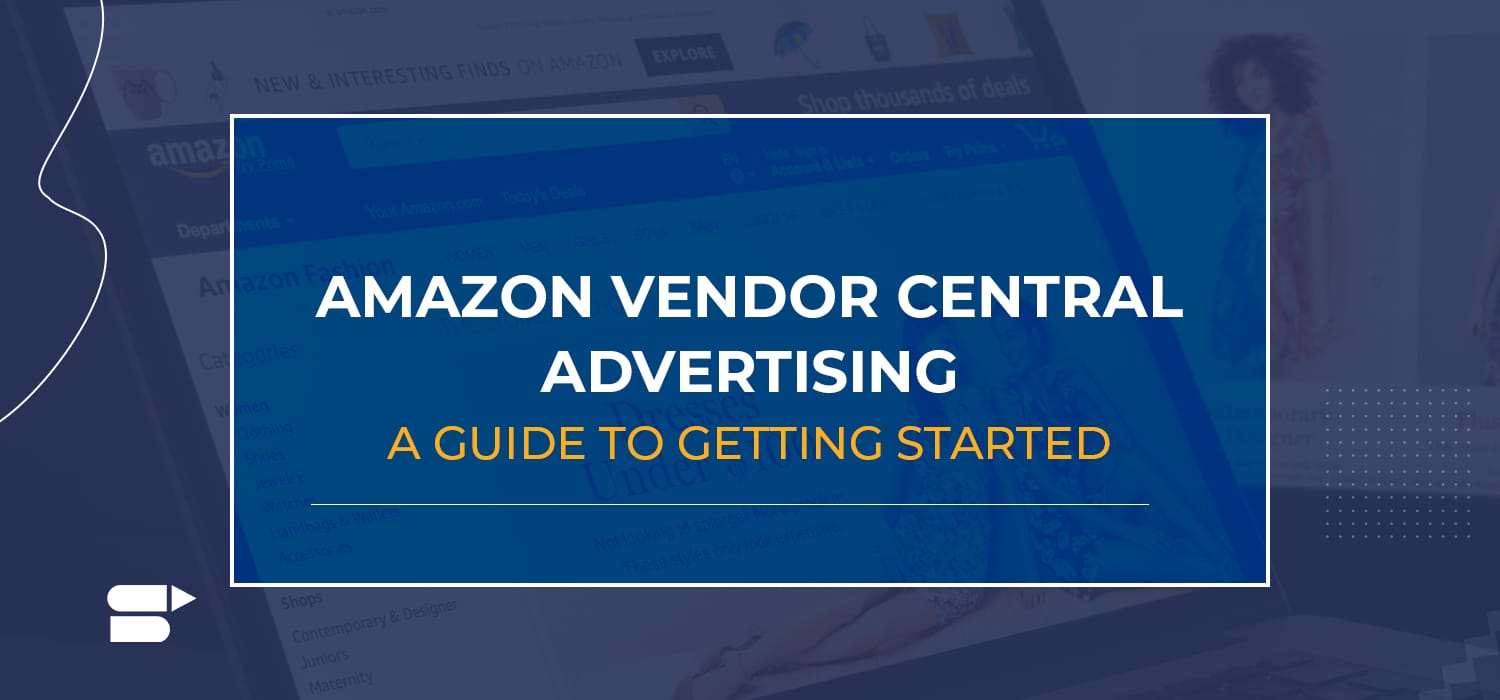

Erna
June 23, 2021Your blog provided us valuable information to work on. You have done a marvelous job!
Arishekar N
July 6, 2021Thank you.
Carroll
June 23, 2021I like this blog!! It’s a masterpiece for amazon sellers
Arishekar N
July 6, 2021We are happy to hear that you liked the blog.